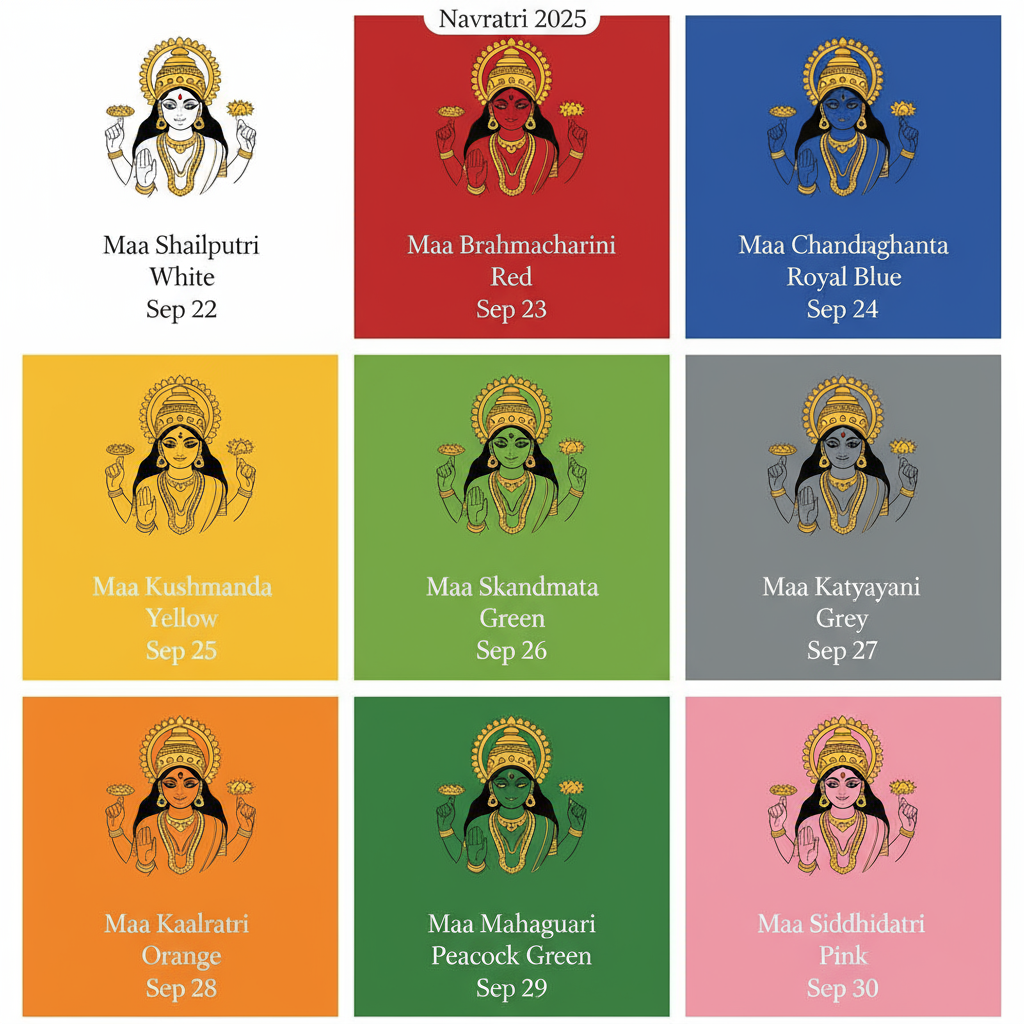Complete Guide to Navratri 2025 Colours with Date, Goddess and Rituals
Navratri is one of the most important Hindu festivals celebrated with devotion and joy across India. In 2025, Shardiya Navratri will begin on September 22 and end on October 2. Each of the nine days is dedicated to one form of Goddess Durga and is associated with a special colour. Devotees wear clothes of that colour to honor the Goddess and bring positivity into their lives.

This guide explains the Navratri 2025 colours with date, their meanings, and the goddess worshipped each day.
9 Days of Navratri 2025 Colours and the Goddess Worshipped Each Day
Also Check: Navratri 2025: Significance, History & 9 Empowering Lessons
Navratri Colours 2025: Meaning of Nine Days and Their Importance
1. September 22 2025 – Day 1 – White – Maa Shailputri
White stands for purity and peace. Devotees wear white on the first day to seek blessings of Maa Shailputri.
2. September 23 2025 – Day 2 – Red – Maa Brahmacharini
Red symbolizes energy and passion. This day is dedicated to Maa Brahmacharini who blesses devotees with strength.
3. September 24 2025 – Day 3 – Royal Blue – Maa Chandraghanta
Royal Blue represents calmness and stability. Maa Chandraghanta brings peace and courage.
4. September 25 2025 – Day 4 – Yellow – Maa Kushmanda
Yellow is a colour of happiness and brightness. Maa Kushmanda is believed to spread positivity and good health.
5. September 26 2025 – Day 5 – Green – Maa Skandamata
Green shows growth and harmony. On this day, Maa Skandamata blesses devotees with prosperity.
6. September 27 2025 – Day 6 – Grey – Maa Katyayani
Grey stands for balance and strength. Maa Katyayani is worshipped for courage and marital happiness.
7. September 28 2025 – Day 7 – Orange – Maa Kaalratri
Orange reflects energy and enthusiasm. Maa Kaalratri removes fear and protects her devotees.
8. September 29 2025 – Day 8 – Peacock Green – Maa Mahagauri
Peacock Green is a colour of freshness and hope. Maa Mahagauri symbolizes purity and forgiveness.
9. September 30 2025 – Day 9 – Pink – Maa Siddhidatri
Pink stands for love, compassion, and kindness. Maa Siddhidatri is worshipped for wisdom and success.
Significance of Navratri Colours 2025
Each Navratri colour has a deep meaning. Wearing these colours is believed to attract positive energy, peace, and blessings of the Goddess. The sequence of nine colours changes every year depending on the weekday the festival begins. Following the Navratri 2025 colours with date helps devotees connect deeply with rituals and traditions.
Chaitra Navratri 2025
Apart from Shardiya Navratri, Chaitra Navratri 2025 will also be celebrated in the spring season. Both Navratris honor Goddess Durga and her nine forms, with devotees observing fasts, performing pujas, and wearing traditional attire linked to the sacred colours of the festival.
Also Read: Navratri 2025: Meaning, Rituals, and Celebrations
How to Celebrate Navratri 2025
Begin each day with prayers to the Goddess of that day.
Wear the specific Navratri colour 2025 to invite positivity.
Offer flowers, sweets, and fruits as per tradition.
Participate in Garba, Dandiya, and other cultural celebrations.
Read Durga Saptashati and chant mantras for blessings.
Navratri is a celebration of devotion, discipline, and positivity. By following the Nine Navratri colours 2025 with their dates and meanings, devotees can connect with the divine power of Goddess Durga and invite peace, prosperity, and happiness into their lives.
FAQs on Navratri 2025 Colours with Date and Their Significance
1. When will Navratri 2025 be celebrated?
Navratri 2025 will be celebrated from September 22 to October 2.
2. How many colours are there in Navratri 2025?
There are nine Navratri colours, one for each day dedicated to a form of Goddess Durga.
3. What is the first day Navratri colour 2025?
The first day of Navratri 2025 is White, dedicated to Maa Shailputri.
4. What is the difference between Shardiya Navratri and Chaitra Navratri?
Shardiya Navratri is celebrated in autumn while Chaitra Navratri is celebrated in spring. Both honor Goddess Durga and her nine forms.
5. When is Durga Puja celebrated in 2025?
Durga Puja in 2025 begins on September 28 and continues till October 2, overlapping with the last days of Navratri. It marks the worship of Goddess Durga’s victory over Mahishasura.
6. What date is Dussehra in 2025?
Dussehra, also called Vijayadashami, will be celebrated on October 2, 2025. It is the tenth day after Navratri and symbolizes the triumph of good over evil.







